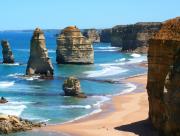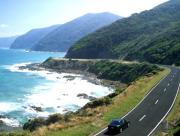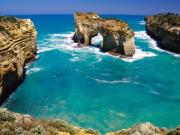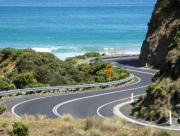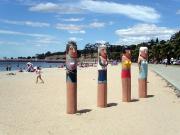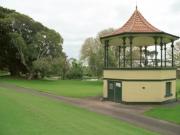Great Ocean Road
The Great Ocean Road skirts the Victorian coastline from Geelong, west to Nelson on the South Australian border and is without question one of the great scenic drives anywhere in Australia. It is also a tribute to the determination of soldiers who returned from World War I and used picks and shovels to build the road to commemorate their comrades who died in the war.
Need some where to stay? Check out our Great Ocean Road Accommodation list.
Bass Strait, which separates Victoria and the island state of Tasmania to the south, is renowned for its rough seas in bad weather. The rugged 440km coastline, which the Great Ocean Road follows, has claimed more than 700 ships and many hundreds of lives, most in the 1800s. Many perished far from settled areas and only 200 wrecks have been found. Fifty are marked along the Historic Shipwreck Trail between Cape Otway and Nelson with roadside signs and plaques overlooking the places where they foundered. Underwater plaques have been placed near many of the wrecks, which can be reached by scuba divers.
The tour route begins at Geelong at the beginning of the Bellarine Peninsula, including historic Queenscliff and Point Lonsdale overlooking The Rip, the narrow and treacherous entrance to Port Phillip Bay. The southern (ocean) side of the peninsula has some of Australia's best surfing beaches. These include Torquay and Bells Beach. Torquay is a major centre for the manufacture of surfing equipment and many claim it has the best waves west of Hawaii. The Surfworld Surfing Museum, open daily, includes displays from historic memorabilia to interactive videos. Bells Beach is frequently host to major international surfing championships.
The Great Ocean Road (designated B100) begins at Torquay. Short side roads lead to Bells Beach and Point Addis with its spectacular coastal views.
Heading west, the small town of Anglesea offers good surf and calm water swimming at Point Roadnight. Resident kangaroos inhabit its golf course, grazing or lazing under its trees. The area's cliffs are a popular jumping off spot with hang-gliders. The road passes through Aireys Inlet to Lorne, a seaside resort town with plenty of cafes, restaurants and picnic areas. The Angahook-Lorne State Park covers the hills above the road from Anglesea to Kennett River. There are 50km of sign-posted walking tracks.
The 13,000 hectare Otway National Park with its towering rainforest trees straddles the Great Ocean Road as it runs west of Apollo Bay. A 45 minute walk from Maits Rest wanders from the road through ferns and beech and myrtle trees 300 years old. The old Cape Otway lighthouse is at the end of a short track, which runs south from the main road 4km beyond Maits Rest. Standing on the southernmost point along the Great Ocean Road, it marked the entrance to Bass Strait. A modern solar-powered light now does the job. Lighthouse tours are available.
The road swings inland to Lavers Hill, the highest point on the route. A Heritage Trail leads past an old timber mill. Johanna Beach, at the end of a track which runs left from the Great Ocean Road soon after it leaves the coast at Glenaire is considered one of the best surfing beaches on the coast, but it is extremely dangerous for swimming.
One of Australia's most spectacular stretches of coastline is the 27km stretch of the Port Campbell National Park, which runs from Princetown through Port Campbell to Peterborough. This area is home to the 12 Apostles, which jut out of the sea near the limestone cliffs from which they were carved by the sea. These unique outcrops are breathtakingly beautiful. Steps lead down a 70 metre (230 foot) cliff face near the Apostles to a beach, to give a sea level view of these amazing outcrops. Lookouts have been placed at strategic points along the coast, which is the graveyard for many ships. The most spectacular views are when the sea is roughest, for those with a head for heights. The winds and pounding waves leave no doubt about its name - The Shipwreck Coast. A display at nearby Glenample Station near Princetown, the first pastoral property (ranch) in the area, tells the story. It is open Friday to Monday from mid-September to mid-July. The main lookouts in the Port Campbell National Park, all signposted along the Great Ocean Road, are the Loch Ard Gorge where the ship's survivors drifted ashore, London Bridge which was a double arch rock formation formed by the sea until one arch collapsed in 1990, The Arch formed by the sea cutting through a rock ledge, The Grotto and the Twelve Apostles.
Warrnambool, 263km from Melbourne, is the largest settlement on the Great North Road and an ideal place to stay a night. First settled in the 1830s as a whaling and sealing port, it has several museums, art galleries and craft studios. A colony of the tiny Fairy Penguin lives on Middle Island, which visitors can walk out to at low tide. Warrnambool is a breeding ground for the rare Southern Right Whales, which arrive from the waters of the Southern Ocean around Antarctica between May and September to give birth. An observation platform overlooking the shallow water of nearby Logans Beach provides good views of the mothers and their calves. The Flagstaff Hill Maritime Museum, designed to present the way an early fortified coastal town may have looked, incorporates 1887 fortifications, old and recreated buildings. It has 2 working lighthouses and a collection of vessels from bygone days, including a small passenger steamer. Flagstaff Hill opens daily from 9am to 5pm. The restored 10-year-old Hopkins River Boathouse in Simpson Street is also full of nautical interest. Nearby Port Fairy, on the bank of the Moyne River 28km west of Warrnambool, is a gem of a seaside town with a sheltered harbour and its own fishing fleet.The town was very wealthy in its heyday and has preserved many of its historic buildings built of stone or timber. Some of the tiny stone whalers cottages remain. Port Fairy plays host to Australia's largest folk music festival in March, and a classical music festival in October. Both Port Fairy and Warrnambool are geared for tourism with numerous cafes, restaurants and boutique shops.
The Great Ocean Road continues west to Portland and Nelson, which is on the South Australia border. The Great Ocean Road route between Geelong and Warrnambool is 270km long, with a recommended travelling time (no stops) of 5.5 hours. The trip to Portland takes another 1.5 hours with another hour to Nelson. Though it is well worth continuing, visitors with limited time can turn north at Warrnambool and take the Princes Highway back to Geelong, covering the 190km journey in about 2.5 hours. Melbourne is another hour further on.
Portland was the first permanent white settlement in Victoria, established in 1834 a couple of years before Melbourne. It is a large town of 11,000 people that produces almost half of Victoria's crayfish (lobster) catch. Portland has more than 200 restored heritage buildings, including the Portland Inn built in 1840 and the Packet Inn built in 1842. The Portland Inn is the State's oldest. Portland has some great vantage points including the scenic drive along Bridgewater Road to Bridgewater Bay where whales are often seen between May and October. The 24-metre tower of the Cape Nelson Lighthouse and Battery Point offer sweeping coastal views. The fortified gun battery built in 1889 to fend off a feared Russian invasion has been fully restored. Bridgewater Bay just west of Portland between Cape Nelson and Cape Bridgewater is a safe place to swim and surf in fine weather, but quickly turns into a raging maelstrom in south-easterly winds. Huge waves pound the cliffs, which are up to 130 metres (over 400 feet) high. Australia's largest colony of fur seals, about 650 strong, inhabits Cape Bridgewater. Visitors can watch them from a viewing platform or take a 45-minute boat ride (weather permitting) for a closer look.
Travellers heading for South Australia can continue through Nelson to Adelaide. Otherwise turn north at Portland on the Henty Highway to Hamilton, then east on the Hamilton Highway to return to Geelong and Melbourne. The Great Ocean Road deserves time. It is not a route for fast driving. Visitors who want to see the Bellarine Peninsula should book their first night at either Geelong or Queenscliff. There is plenty of accommodation in townships from here to Warrnambool. This stretch of the road is spectacular and will take time to travel along it and take in the sights. A night at Warrnambool or Port Fairy is recommended, although travellers who choose to go on to Portland may prefer to continue on. The return journey from Warrnambool or Portland to Geelong and Melbourne does not warrant an overnight stop on the way.

